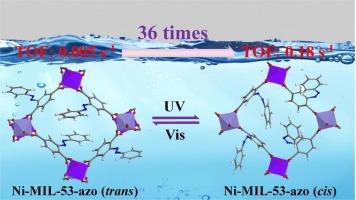Constructing azobenzene-decorated Ni-MOF toward efficient oxygen evolution reaction
IF 13.2
1区 工程技术
Q1 ENGINEERING, CHEMICAL
引用次数: 0
Abstract
Swithcing MOFs configuration utilizating external stimulus to promote the electrocatalytic oxygen evolution reaction (OER) is highly desired but remaines huge challenge. Here, the azobenzene-decorated Ni-MIL-53-azo is elaborately synthesized to successfully achieve this goal for the first time. Electrocatalytic results indicate that the OER activity can be significantly enhanced by the trans-to-cis isomerization of azobenzene in Ni-MIL-53-azo achieved upon UV light irradiation. Compared to Ni-MIL-53-azo (trans), Ni-MIL-53-azo (cis) shows the 36 times improvement of TOF. Interestingly, Ni-MIL-53-azo (trans) with poor activity can be reversiblely switched to Ni-MIL-53-azo (cis) with excellent activity, which is ascribed to the reversible isomerization of azobenzene group in Ni-MIL-53-azo. As demonstrated by the theoretical computation, Ni-MIL-53-azo (cis) can exhibit the stronger absorption strength toward *OH than Ni-MIL-53-azo (trans), thus effecitvely triggering OER process. This intriguing adjustment of OER activity stimulated by light irradiation may give new insight into highly efficient OER electrocatalysts.

偶氮苯修饰Ni-MOF高效析氧反应的构建
利用外界刺激改变mof的结构来促进电催化析氧反应(OER)是人们迫切需要的,但仍然是一个巨大的挑战。在这里,我们精心合成了偶氮苯修饰的Ni-MIL-53-azo,首次成功实现了这一目标。电催化结果表明,紫外光照射使ni - mil -53-偶氮化合物中的偶氮苯发生反-顺异构化,OER活性显著提高。与ni - mil -53-偶氮(顺式)相比,ni - mil -53-偶氮(顺式)的TOF提高了36倍。有趣的是,活性较差的ni - mil -53-偶氮(反式)可以可逆转化为活性优异的ni - mil -53-偶氮(顺式),这归因于ni - mil -53-偶氮中偶氮苯基的可逆异构化。理论计算表明,与Ni-MIL-53-azo (trans)相比,Ni-MIL-53-azo(顺式)对*OH的吸收强度更强,从而有效触发OER过程。这种有趣的光激发OER活性的调节可能为高效OER电催化剂提供新的见解。
本文章由计算机程序翻译,如有差异,请以英文原文为准。
求助全文
约1分钟内获得全文
求助全文
来源期刊

Chemical Engineering Journal
工程技术-工程:化工
CiteScore
21.70
自引率
9.30%
发文量
6781
审稿时长
2.4 months
期刊介绍:
The Chemical Engineering Journal is an international research journal that invites contributions of original and novel fundamental research. It aims to provide an international platform for presenting original fundamental research, interpretative reviews, and discussions on new developments in chemical engineering. The journal welcomes papers that describe novel theory and its practical application, as well as those that demonstrate the transfer of techniques from other disciplines. It also welcomes reports on carefully conducted experimental work that is soundly interpreted. The main focus of the journal is on original and rigorous research results that have broad significance. The Catalysis section within the Chemical Engineering Journal focuses specifically on Experimental and Theoretical studies in the fields of heterogeneous catalysis, molecular catalysis, and biocatalysis. These studies have industrial impact on various sectors such as chemicals, energy, materials, foods, healthcare, and environmental protection.
 求助内容:
求助内容: 应助结果提醒方式:
应助结果提醒方式:


